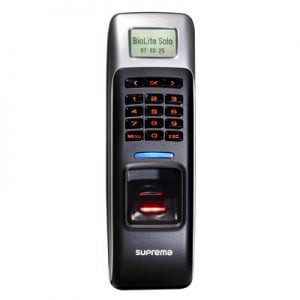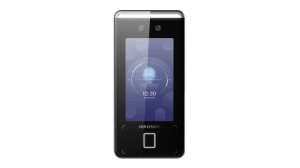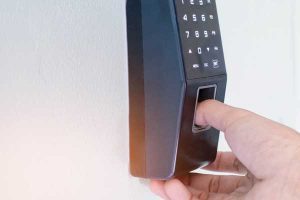Advantages & Disadvantages of Different Kinds of Biometric Systems/Fingerprint Scanners
What springs to mind as soon as you hear the phrase “biometrics”? Or maybe it’s a feature on one of Batman’s cutting-edge instruments that he employs as the world’s best detective. Biologists measuring a vial of cells; a science teacher’s grading rubric they use for their students’ exams
Consider biometrics as having two components: “Bio” as in “biology.” The scientific study of life and living things is called biology. Metrics are a rules-based method of measuring data, often used for comparing or monitoring reasons. Metrics are not merely a tool the world (apart from the USA) employs to measure the distance between locations.
Metrics are quantitative, but biology is mostly qualitative. How can two apparently unrelated items work together to produce an authentication application that promotes safety and security in the digital world while bridging the reality gap? Today, many experts believe that biometric identification is ultimately more secure than conventional passwords, two-factor authentication, and knowledge-based responses because biometric identifiers are unique to each individual.
We’ll clarify some often asked issues regarding biometrics, explain how a fundamental biometric recognition system integrates with a person’s identity, and go through the many biometric screening options now available. We’ll also talk about the benefits and drawbacks of biometrics.
Biological and behavioral biometric types and their indications
Congratulations if you’ve ever used your finger to unlock a smartphone, scanned your face to check how much money is in your bank’s app, or called “Hey Alexa” to get the temperature of an egg. Your biometrics have been used. Biometrics may be categorized as either physiological or behavioral, as the ones utilized in the aforementioned example.
A “physiological” biometric indicator is a particular physical pattern on a person’s body, and fingerprints are the most popular biometric indicator in use today. In addition to being a physiological biometric, a scan of the same person’s face, or face recognition, may be segmented to reveal various physiological biometric sensors, such as ear shape, eye width, nose shape and length, hair type, and others. On mobile devices like smartphones, laptops, and tablets, tools like fingerprint readers and face recognition software are often used to evaluate physiological biometric data.
A person’s voice is a “behavioral” biometric indication, meaning that it exhibits certain patterns that are connected to their behavior. A gadget’s physical fingerprint may be removed, but a profile of you can be created by measuring how you use the device. Behavioral biometric indicators are being utilized more often in digital apps and online to track and identify a person based on a set of patterns established by their behavior, even if there are some crossovers to physical attributes. As an illustration, the majority of contemporary businesses with a digital platform will consider behavioral traits like mouse scrolling on a website, swiping on a website to indicate mobile browsing, or clicks vs. hard presses as one method of biometric recognition that can help create a profile of a person’s identity.

Physiological – body composition
1. Your finger’s ridges, which form your fingerprint
2. Hand geometry, including the length of your fingers and the distance between them.
3. Your palm’s hand lines and thickness/width are known as your palm print.
4. DNA – genetic sequence analysis
Blood type number five
6. Facial dimensions, such as the form and size of the head, the distance between the eyes, the color of the hair, etc.
7. The color and shape of the iris and retina
8. Veins – patterns of veins in the hands, eyes,
9. The EKG and heartbeat

behavioral patterns seen in people’s actions
1. Keystroke dynamics and rhythmic typing
2. A walking style
3. Tone of voice and speaking
4. Motions
5. Scrolling and swiping on the web
6. Recognition of written text such as a signature or typeface
7. IP addresses and geolocation
8. Buying customs
9. Using devices
10. Cookies and browser history

How does biometrics function? What purposes do biometrics serve?
voice, face, and biometrics
Returning to the introduction, we divided the term “biometrics” into the terms “biology” and “metrics.” Metrics sometimes entail comparing data sets to seek for patterns and trends. When discussing the “lock and key” and token approaches to user identification and authentication in contemporary password systems, identity experts frequently use the phrase “biometrics,” which performs the same task by comparing a biological data set of “something a person has” with “something they are.”
Here is how a fundamental system operates in terms of biometrics in technology, whether it be behavioral or physiological:
1. Biometric software, such as “facial recognition,” records a user’s biological input (in this case, a face)
2. The program evaluates the capture to produce a template or “lock” of baseline data points that will serve as the deciding data point for further usage.
3. During the enrollment process, the biometric parameters that are measured and collected are transformed and saved as data in internal hardware on the utilized device or on a cloud platform.
4. Next, the previously calculated string of data in the “lock” is compared to any fresh inputs as a possible “key” via biometric sensors to the “lock.” The service or account will only be unlocked by matching biometrics, whether they be physiological or behavioral traits, which are offered to verify a person’s identification.
Important details: The biometric template, or the “lock,” as we’re calling it here, isn’t the whole picture; rather, it’s a code created to describe the biometric properties of the “lock” image within the context of the particular biometric technology. After scanning their finger to their phone, if someone were to see the data of a fingerprint they submitted in the template “lock,” it would display a series of code rather than a zoomed-in image of their finger prints.
Any time a biometric input is scanned into a system as a “key” to unlock access after enrolment and storage, the biometric is compared to and measured by the data that’s provided in the template “lock” in order to ensure it is accurate. The door is unlocked if the biometric key matches. A user is rejected if the biometric key doesn’t match.
The fact that the “locks” or templates aren’t complete representations of the whole biometric data a user supplies is one of the primary benefits of biometric authentication. As an illustration, if a hacker managed to gain access to a database of biometric “locks,” they wouldn’t immediately have access to private pictures of people’s biometrics or be able to instantly unlock all of their services that use biometrics with their “key” because they don’t actually contain the biometric traits or characteristics.
Because current commercial technology prohibits biometric traits from being digitally re-engineered for malicious reasons, biometrics are able to provide a high degree of security. To use and be authorized by a fingerprint scanner, you must possess the actual, physical fingerprint. The creation of technology to reproduce biometric features, however, is a question of “when,” not “if,” given the pace of technological advancement.
Most experts concur that the optimum biometric system should demand the presentation of a live biometric each time for access. Additionally, a multi-factor authentication system that combines biometric features like fingerprint readers in conjunction with voice recognition in addition to other more conventional items like 2FA or passwords would provide the highest level of security. A “lock” shouldn’t ask for only biometric identification solutions as the “key.”
Biometric technology types and applications
There are a ton of services and apps that use biometric technology nowadays. Here are some typical biometrics that individuals often use for both behavioral and physiological biometrics:
1. Personal hardware, such as cell phones, laptops, computers, and tablets.
2. Before completing financial transactions, such as wire transfers, it is common to request identification verification from the recipient.
3. Healthcare – By restricting the exposure of medical information to unapproved parties, biometrics may assist clinics, hospitals, and doctors retain better records of their patients.
4. Law enforcement – To identify and monitor criminals, agents utilize biometrics every day. DNA testing and fingerprinting, anyone? Prisons and jails also handle convicts using biometrics. For instance, agents may photograph an inmate’s tattoos in order to trace their membership with criminal organizations and create a biometric profile.
5. Airports – Facial recognition biometrics are being used in several contemporary airports. Travelers may sign up by having a camera take a picture of their face and eyes. Passengers no longer need to wait in lengthy lines to be processed while flying; instead, they may enter an accelerated line, glance into a camera, and have their biometric data matched.
You can see that biometric identification and verification is essential to the contemporary technological environment and is used in more contexts than contemporary users of it fully comprehend.
While the usage of biometric data and authentication is expanding across many facets of contemporary life, concerns have been raised about the security and privacy of the users and customers who provide biometric input to corporations and governments, as well as the intended uses. Why is it necessary for a company to know what browser I use? What happens if my biometric information is stolen? A password can always be changed, but is it possible to alter a fingerprint?
We’ll discuss both the benefits and drawbacks of biometric authentication in the sections that follow.
Benefits of biometric identification
There are many benefits to using biometric authentication in contemporary technological and digital applications, including:
High security and assurance – Biometric identification helps to confirm identity by answering the questions of “something a person has and is.”
user encounter – Practical and quick
Cannot be transferred – Each individual has access to their own collection of biometrics.
Unfalsifiable – Biometrics are difficult to forge or steal
high assurance and security
By confirming a measurable, in-person characteristic as something the user is both as well as something the user possesses, biometrics provide suppliers higher degrees of confidence that a person is genuine. Due to the likelihood that the majority of user passwords, PINs, and personal identification information have been exposed in a data breach, fraudsters who have access to the conventional authentication methods may access billions of accounts. Though a fraudster may be aware that a person uses their dog’s name and a few lucky numbers for most of their online accounts, they can’t use their fingerprint to unlock an account if they can’t provide it immediately. This adds a barrier for fraudsters that only a real, authorized user can get around. Additionally, a robot would now have difficulty passing an iris scan since biometric security can only be given by real, breathing individuals.
The user experience is quick and convenient.
Although the underlying procedure for biometric identification is sophisticated, it is remarkably simple and fast from the user’s perspective. It takes less time to place a finger on a scanner to unlock an account than it does to type a lengthy password with several special characters. Additionally, most users often make the error of forgetting their passwords. What are the odds that you may forget your own biometrics? Never!
Non-transferable
Biometric authentication demands the presence of its input during authorisation. The only method to use the majority of biometric authentication systems is with a physical application; you cannot transmit or exchange a physical biometric online.
Almost foolproof
It is almost hard to recreate biometrics like facial patterns, fingerprints, iris scans, and others using the technologies available today. Your fingerprint will not perfectly match someone else’s by chance of one in 64 billion[1]. To put it another way, you have a higher chance of winning the lottery than a hacker attempting to access your biometrically protected account if you have the same fingerprint.
Biometric authentication’s drawbacks
Even if it offers more security, effectiveness, and simplicity, biometric authentication and its implementation in contemporary technology and digital applications have drawbacks:
Costs: Biometric security requires a large investment.
Data breaches: It’s still possible to attack biometric databases
Tracking and data – Users’ privacy may be restricted by biometric equipment like face recognition systems.
To reduce biometric demographic bias, machine learning and algorithms must be very sophisticated.
erroneous conclusions and inaccuracies – Select users may still experience false rejections and false accepts, blocking them from accessing systems.
Costs
It should come as no surprise that installing a more sophisticated security system would involve large financial outlays. According to a Spiceworks poll from 2018, “the top reason for not using biometric authentication” is cost, which is cited by 67% of IT experts. A corporation would not only have to pay for the transition to biometric authentication; according to 47% of those questioned, their present systems would also need to be upgraded in order to enable the switch to biometric authentication on their devices.
Violation of data
Hackers often target companies and governments that gather and keep consumers’ personal data. In order to keep ahead of fraud developments, enterprises must manage sensitive biometric data with more security and vigilance since it is irreplaceable. This is costly and technically challenging. A password or pin may always be changed if it has been hacked. The same cannot be true for a person’s biometrics, either physiological or behavioral.
Data and tracking
The privacy of users must be taken into account as the usage of biometric identification systems, such as face recognition technology and other biometric security measures, rises across the globe. A user stands the danger of leaving a permanent digital trace that might be followed by malicious actors when biometrics are transformed into data and kept, especially in locations or nations with extensive surveillance measures. Facial recognition software has been widely utilized by corporations and governments to follow and identify individuals with unnerving precision, severely compromising privacy[3]. Biometric information may become a permanent digital tag that can be used to monitor someone, both knowingly and unknowingly, as surveillance levels rise.
Bias
It may be difficult for providers to minimize demographic bias in biometrics while still confirming applicants’ identities during digital onboarding. Technology abuse or improper usage on purpose may lead to exclusion and discrimination. Cross-demographic performance may be unpredictable and restrict consumer access to necessities like finance and the rising spectrum of digital services without a tested, document-centric identity validation solution.
Erroneous results and inaccuracy
The majority of popular biometric authentication techniques depend on insufficient data to confirm a user’s identity. For instance, during the registration step, a mobile biometric device will scan a whole fingerprint and turn it into data. Future fingerprint biometric verification, however, will only require a portion of the print to confirm identification, making the process speedier overall. By comparing similarities of partial prints to the complete biometric data, a research team from New York University in 2018 was able to fraudulently crack fingerprint authentication with a 20% success rate.